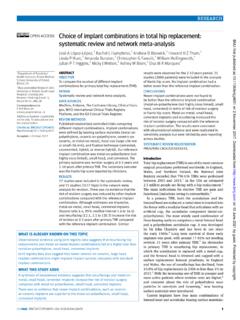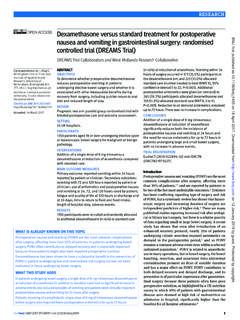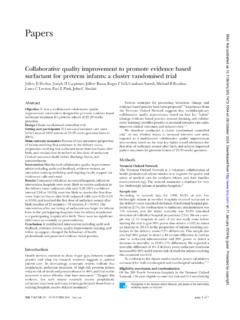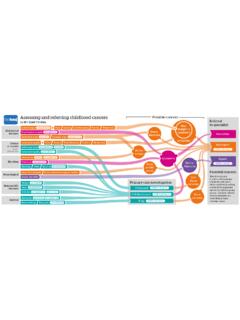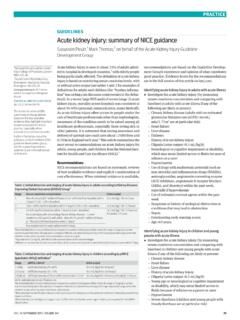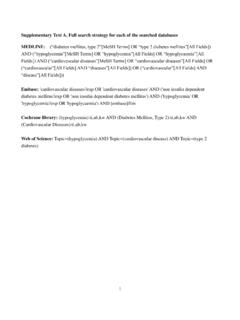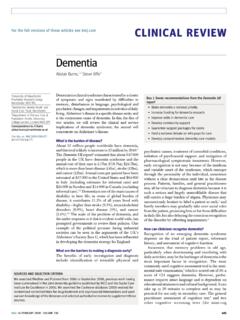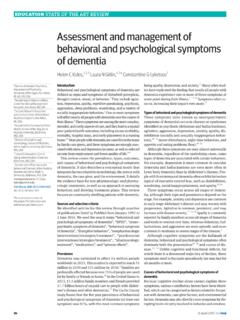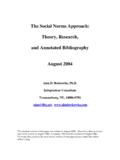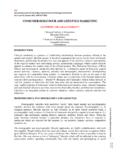Transcription of RESEARCH - bmj.com
1 RESEARCHD etecting implausible social network effects in acne, height,and headaches: longitudinal analysisEthan Cohen-Cole, financial economist,1 Jason M Fletcher, assistant professor2 ABSTRACTO bjectiveTo investigate whether network effects can bedetected for health outcomes that are unlikely to besubject to network analysis common in network studies,such as logistic regression analysis , controlled for ownand friend s lagged health status. Analyses controlled forenvironmental of the National Longitudinal Study ofAdolescent Health (Add Health).Participants4300 to 5400 male and female adolescentswho nominated a friend in the dataset and who were bothlongitudinally outcomes, including headacheseverity, acne severity, and height self reported byrespondents in 1994-5, 1995-6, and network effects were observed in theacquisition of acne, headaches, and height.
2 A friend sacne problems increased an individual s odds of acneproblems (odds ratio , 95% confidence interval ). The likelihood that an individual had headachesalso increased with the presence of a friend withheadaches( , );andanindividual sheightincreased by 20% of his or her friend s height ( , ). Each of these results was estimated by usingstandard methods found in several publications. Afteradjustment for environmental confounders, however, theresults become uniformly smaller and should be cautious inattributing correlations in health outcomes of closefriends to social network effects, especially whenenvironmentalconfoundersarenotadequa telycontrolledfor in the credible estimates of the effects of socialnetworks in choices and outcomes in health isimportant for increasing our understanding of thedeterminants of such outcomes as well as suggestingpolicies that could lead to improving health.
3 Policiesthatareabletoinfluencenetworkeff ectscouldproduce social multipliers in the benefits, where the totaleffect of the policy is magnified via social work has examined potential social networkeffects in outcomes such as obesity, smoking, andalcohol use. Christakis and Fowler have presentedevidence of the person to person spread of obesity andquitting smoking among et al pro-posed that back pain might be a communicabledisease. 3 Many methods used to estimate social networkeffects are subject to potentially large biases that resultin the increased likelihood of detecting social networkeffects where none exists. For example, the use ofstandard econometric methods from literature on peereffects substantially reduces evidence of social networkeffects in work that claimed to findsocial contagion in the diffusion of prescription drugswas confounded by marketing standard methods we examined whether onecan find network effects using common methodseven in health outcomes that are unlikely to betransmitted socially.
4 Acne, headaches, and issues in estimating social network effectsThe general form of the regression equationis typicallysome version ofhealthigt= healthjgt+ Xit+ gt+ igtwhere a health outcome of individualiin referencegroupgat timetis determined by the health of otherindividuals in the reference group, own characteristicsX, group level factors , and an error term. We focusedon two main empirical difficulties in estimating socialnetwork effects ( ) within reference groups: firstly, thatfriendship selection is non-random, which leads tocorrelation between the error term and friend s health,and, secondly, that confounding factors affect allmembers of the reference group ( ).
5 There are manyother potential econometric issues, including thereflection problem6 it is difficult to separate indivi-dual A s effect on individual B from individual B seffect onindividualA and the properdefinition oftherelevant reference first difficulty we focus on, called selection in theeconomicsliteratureandhomophilyelsewh ere,createscorrelations in health outcomes because individuals ingood (or bad) health tend to associate with otherindividuals in good (or bad) health. This non-randompattern of association across individuals can lead tocorrelations in health outcomes between friends thatare not caused by direct social network Reserve Bank of Boston,600 Atlantic Avenue, Boston, MA02210, USA2 Yale University, School of PublicHealth, 60 College Street,New Haven, CT 06510 Correspondence to: J this as:BMJ2008;337:a2533 |ONLINE FIRST | 1 of 5 on 5 December 2018 by guest.
6 Protected by : first published as on 4 December 2008. Downloaded from The second difficulty, environmental confounding,can occur when a feature of the shared environmentaffects all individuals in the same reference group. Forexample, a fast food restaurant, convenience store, orgym opening near a school could simultaneously affectthe weight of all individuals in networks within theschool. Importantly, the presence of (often unmea-sured) shared surroundings can lead to erroneouslyimplicating social network effects in individual out-comes where none are several common approaches to has been addressed through the use of fixedeffects or random assignments of reference groups,such as the practice of randomly assigning first yearroommates at some authors attempt toovercome selection effects by including lagged vari-ables in the empirical model, though in general thispractice produces biased.
7 Newresearch that combines multiple strategies to addressthe multiple difficulties is an important next step indetecting social network problem of confounding has generally beenaddressed by controlling for a rich set of individual,family, and environmental characteristics or usingfixed effects at the group problem, ofcourse, is that social groups are often faced with similarenvironmental characteristics. If these are neglected,one can improperly interpret the results to imply thattrue network effects argue that the test statistics drawn from what wecall the standard approach are incorrect. In parti-cular, because RESEARCH has not accounted for theproblems above, the standard errors from the simplemodels will be unreasonably small.
8 Of course, ifstandard errors are too small, a researcher will bemore likely to reject, incorrectly, any given is simple in empirical work to assume thatwhatever information is available in the dataset is thesame information that describes the social environ-ment in which people live. In particular, it is commonto assume that the set of variables are the appropriateones to differentiate environmental confounders fromtrue network effects. The problem is that the datasetsused were rarely, if ever, constructed with this type ofanalysis in mind. As such, the individual and groupcharacteristics are typically more appropriate forevaluating individual level health outcomes ratherthan group level interactions.
9 To differentiate betweennetwork effects of obesity and confounders, forexample, one would want to know the pattern of fastfood restaurants or the caloric content of the schoolcafeteria available to the social network. Inclusion ofthe individual s race, income, etc, might be reasonableproxies for some studies but cannot distinguish twootherwise similar groups that have different environ-ments. Estimating a regression of any type without thissalient information might show a network effect ifone school is next to a fast food restaurant and anotheris there are different approaches to estimatingsocialnetworkeffects,wefocused ontheapproachusedin Christakis and Fowler12:healthigt= healthjgt+ 1healthjgt 1+ 2healthjgt 1+ 3 Xit+ igtThis addresses selection issues by controlling forlagged health outcomes.
10 The claim is that the use ofa lagged independent variable for an alter s weightstatus controlled for homophily. (An alter is a personlinked to the focal person a friend.) Unfortunately,unless selection is conditioned only on this variable,this statement might be spurious. For example, iffriendships are formed based on characteristics like selfesteem, and if self esteem affects both current weightandfutureweightindifferingways,the nadjustmentforcurrent peer weight status will not capture the selfselectionoffriendsbasedonself esteemthatalso affectsfuture could be that currentsmokers who are considering quitting might becomefriends with individuals who they suspect are likely tosuccessfully quit smoking in the future.


